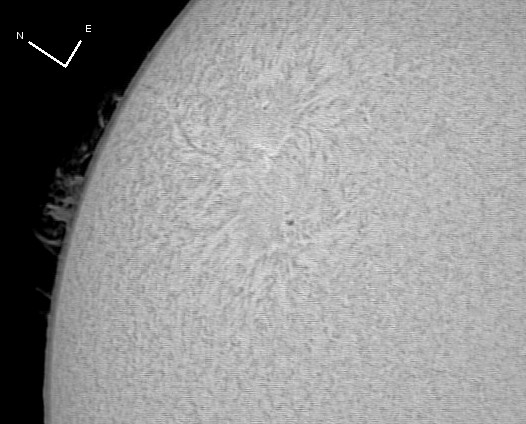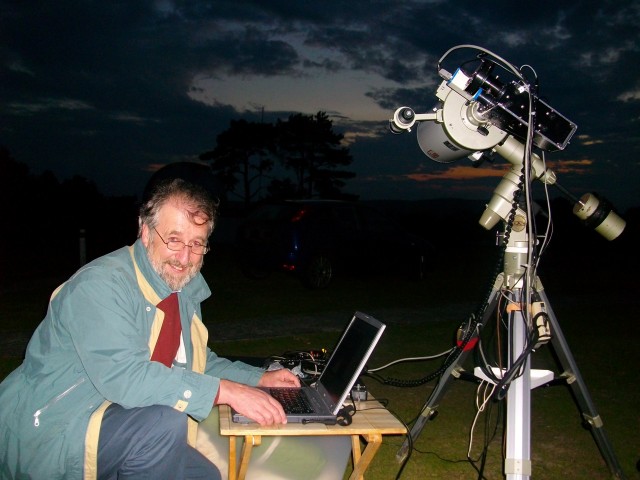Forum Replies Created
-
AuthorPosts
-
Dominic Ford (site admin)
ParticipantPosted by Andrea Tasselli at 18:47 on 2010 Sep 15
Tom,I routinely use an f/4 newt for my planetary imaging so f/5 is just fine.Reg’sAndrea T.
Dominic Ford (site admin)
ParticipantPosted by Tom Moran at 13:05 on 2010 Sep 15
Andrea.I know what you mean about the Newtonian alternative. Problem is the design of my observatory is such that I could fit in an 8 or 10 inch with only a short focal ratio of about f5. Would this still be ok for planetary work?Tom
Dominic Ford (site admin)
ParticipantPosted by Andrea Tasselli at 12:33 on 2010 Sep 15
Hello Tom,In my experience 8" is the minimum to do any meaningful work vis-a-vis planetary imaging. Visually, I would go for as large an aperture as I can afford. Obviously, in visual work, a lot depends on the skill, experience and good eyesight of the observer. Although I am partial to the maksutov design (I have four of them) in all honesty I would rather spend the money on a large newton than on a finer but much smaller Mak-Cass. I’ve heard good things about these chinese 7" maks (but only in the pro version) although overall I don’t think they can compete with the russian ones. This said I do like much more the contrast in my maks (or rather still the darker sky background and star shape) than in my newts but the newts deliver far more punch for the buck, whenever planetary details are concerned.At any rate, if you live not too far from Lincoln you might want to drop by and have a look through an 8" Mak-Cass to see how it feels.Hope it helps,Andrea T.
Dominic Ford (site admin)
ParticipantPosted by Tom Moran at 20:11 on 2010 Sep 14
Hello Andrea.I would like to do both.I read your review of the Tal2K and have taken it from my list. It seems a little ‘agricultural’, with a poor focuser and large central obstructionRegards.Tom.
Dominic Ford (site admin)
ParticipantPosted by Andrea Tasselli at 19:28 on 2010 Sep 14
Hi,To answer properly I would need to know whether it is for visual observations or digital video/webcam. This said any contribution is welcome in any section.Reg’sAndrea T.
Dominic Ford (site admin)
ParticipantPosted by Marlyn Smith at 18:56 on 2010 Sep 14
Tom Moran imaged the Sun today 2010 September 14th. He obviously doesn’t live in Scotland where we are in the middle of a typhoon!

Dominic Ford (site admin)
ParticipantPosted by Robin Leadbeater at 10:54 on 2010 Sep 13
Callum Potter wrote:
Robin (L) – probably the file was too big or the image size too large. To use thetag – has to be at most 800×800 and less than 150kb.
Thanks Callum,I had got the file size down below 150k but I got caught out by the 800×800 limit. images of the epsilon Aurigae spectrum are now attached to the original post and here is another image of me setting up my spectrograph at NLORobin

Dominic Ford (site admin)
ParticipantPosted by Callum Potter at 10:06 on 2010 Sep 13
Robin (L) – probably the file was too big or the image size too large. To use the
tag – has to be at most 800×800 and less than 150kb.I expect this would be the problem – Gary had something similar recently.Regards, Callum
Dominic Ford (site admin)
ParticipantPosted by Marlyn Smith at 09:00 on 2010 Sep 13
To attach files I use Tinypichttp://tinypic.com/Upload the file from your computer onto there and click the second window "for message boards". The file will then paste over here when you use the "reply" option on this forum.
Dominic Ford (site admin)
ParticipantPosted by Marlyn Smith at 17:05 on 2010 Sep 12
 Image by Sheri Lynn Karl 2010 Sept 09 at 1102 UT
Image by Sheri Lynn Karl 2010 Sept 09 at 1102 UT Image by Dave Tyler 2010 Sept 09 at 0853 UT showing filaments on the disk
Image by Dave Tyler 2010 Sept 09 at 0853 UT showing filaments on the diskDominic Ford (site admin)
ParticipantPosted by Robin Vann at 16:06 on 2010 Sep 11
Thanks again Andrea.Yes, I have thought of shimming it but thought I would use a piece of rubber. Thus one could ‘squeeze’ the rubber as one tightened the focuser nuts back into place and have some variation by way of the degree of tightening, rather than having to calculate the thickness of shim required.And yes, the cross-hairs move relative to the centre marker on the primary as the focuser is moved in and out. However, the focuser is fitted with a locking screw and locking it prior to observing results in the cross-hairs remaining centred whatever the position of the focuser.I think we can close the issue now. Thanks to David and Andrea for your ideas. I feel confident about taking this forward myself now.
Dominic Ford (site admin)
ParticipantPosted by Robin Vann at 15:59 on 2010 Sep 11
To attach the image, browse for it (obvious), then hit the ‘
‘ button (non-obvious) before going to preview or submit. It’s probably a good idea to preview before submitting so you can check it’s there.
Dominic Ford (site admin)
ParticipantPosted by Andrea Tasselli at 15:10 on 2010 Sep 11
Actually what matters is that the reflections being centered rather than the actual object, in this case the secondary. If the focuser is tilted with respect to the mechanical axis of the tube, assuming that this can be ascertained with any degree of accuracy, the only way is to use shims (well furnished hardware shops di have them) to de-tilt the focuser. One easy way to assess this is to use a "collimated" laser collimator (some of the cheap ones are not). Once the beam is centered on the primary (I assume the primary is center-marked) moving the focuser up and down the whole length of the drawtube would show shifts in the position of the dot, thus revealing the tilt (and also providing a way to check the correct tilt if shims are used). Obviously this assume the focuser being of a decent sort and thus not bending or shifting while moving.Andrea T.
Dominic Ford (site admin)
ParticipantPosted by Robin Leadbeater at 12:49 on 2010 Sep 11
OK attaching an image obviously did not work. If someone can explain how to do it, I will add itRobin
Dominic Ford (site admin)
ParticipantPosted by Robin Vann at 00:59 on 2010 Sep 10
Yes indeed. I discovered this yesterday afternoon when I successfully lined up the cross-hairs of my Cheshire with the central marker on the primary by adjusting the secondary, and then aligned the reflection of the Cheshire cross-hairs on the said central marker.What resulted was the secondary mirror appearing slightly off-centre under the focuser tube.Hence I think you are correct David: that’s well diagnosed.I now apparently have the optical axis (which we deem to be slightly diagonal to the focuser tube) centred at the cross-hairs of the Cheshire instead of slightly off-centre. Ideally, I suppose one would centre at the focal plane, to completely compensate for the off-centre focuser tube.Later last night, I performed a star test on Capella at about 50° altitude and succeeded, for the first time, in obtaining a beautiful perfectly symmetrical Airy disc slightly intra-focus and extra-focus, with a little flaring which I put down to seeing. The symmetry was only perfect when the star was centred in a 15′ field of view at 280x, some asymmetry beginning to be noticeable about halfway to the edge of the field.The question remains: should I continue as per the new alignment or return to the original one? I am inclined to continue as present as I am now seeing the Airy disc whereas I wasn’t before, though it worries me slightly that it becomes asymmetrical so close to the optical axis.Thanks again everyone for your help.Robin Vann
Dominic Ford (site admin)
ParticipantPosted by David Arditti at 01:40 on 2010 Sep 09
I’m not sure about this, but the problem you describe looks to me to be more likely to be due to the focuser not being square to the tube than incorrect offset of the secondary. This is a hard fault to correct, if present, as most focusers have no capacity for adjustment of how they sit on the tube. However, it does not usually lead to serious optical problems.David
Dominic Ford (site admin)
ParticipantPosted by Robin Vann at 15:32 on 2010 Sep 07
Thanks Andrea.What you say makes perfect sense. If I move my eye slightly off-centre to the axis of the Cheshire, everything lines up, but I then can’t see the inside surface of the Cheshire on both sides. I have also never seen the Airy disc though I have attempted to many times since starting astronomy in May this year. I have previously put this down to the inadequacies of the coarse rack and pinion focuser but, overall, I now suspect the telescope was delivered with the secondary offset incorrectly in the way you describe.I shall now try to move the secondary so that my Cheshire cross-hairs are correctly centred over the centre marker of the Primary before realigning the primary to centre the reflection of the secondary over said centre marker.Robin Vann
Dominic Ford (site admin)
ParticipantPosted by Andrea Tasselli at 15:09 on 2010 Sep 07
I shan’t think you should worry. It means, if I understand correctly what you’re saying, that the secondary position isn’t corrected for the required offset. In other words the optical axis is slightly offset from the mechanical center of the focuser. OTOH, if you don’t see the airy disc ever then things are not quite OK. I would check with a star test whether you’re collimated or not. If it is, and the scope has been given proper time to cool off and the seeing is quite ok you should be able to see the airy disc of a bright star.Andrea T.
Dominic Ford (site admin)
ParticipantPosted by Marlyn Smith at 10:04 on 2010 Sep 07
 This image of sunspot AR1101 was captured by Andy Devey 2010 Sept 03.
This image of sunspot AR1101 was captured by Andy Devey 2010 Sept 03.Dominic Ford (site admin)
ParticipantPosted by Robin Vann at 20:48 on 2010 Sep 06
Thank you for your reply, David, and excuse me for being such a rank beginner.I have always had difficulty doing star tests, never really achieving the Airy disc pattern, possibly due to the inadequacies of the rack and pinion focuser on my Skywatcher 150mm. However, Jupiter is sharp as a button, as was a shadow transit of Io last week, Io’s shadow being pin sharp.So I guess I can leave it for now.To be absolutely accurate, I think the problem is that I haven’t perfectly centered the collimator’s cross-hairs over the centre marker on the primary at stage 2 (the centre diagram).Thanks again :)Robin Vann
-
AuthorPosts
